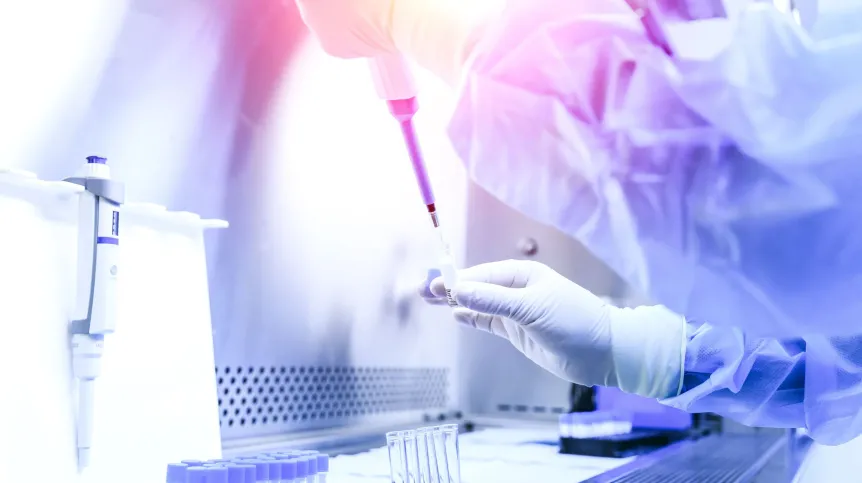
A complicated system of proteins called the Elongator, which is crucial for the proper production of proteins in multicellular organisms, has been described by members of an international research team, including scientists from Kraków.
Elongator consists of many subunits, and any mutations affecting the shape or activity of any of them cause its dysfunctions. At the level of the whole organism, such mutations manifest themselves in the form of various diseases and disabilities.
A KEY COMPLEX
Elongator is a eukaryotic protein complex responsible for inserting a very small chemical group into a specific place in the tRNA anticodon. The presence of this chemical modification is important in the production of proteins that are among the main building blocks of all organisms.
Marcin Jaciuk from the Małopolska Center of Biotechnology of the Jagiellonian University in Kraków said: “Remember that proteins perform many important functions: they are enzymes that accelerate biochemical reactions; they transport oxygen in the blood (haemoglobin); they store various compounds, e.g. iron in the liver (ferritin), build our tissues and are responsible for their movement (actin and myosin).”
As a result of the modification introduced by Elongator, tRNA is recognized and correctly bound by ribosomes during protein synthesis in cells.
'Correctly' means that the interaction of the tRNA anticodon with the mRNA codon is optimal. Finally, the protein synthesis process takes place at the right pace, which allows it to adopt its proper spatial structure, necessary for its function.
One of the Elongator subunits, which in bacteria occurs as a single protein, is responsible for introducing modifications to the tRNA. Scientists from Dr. Sebastian Glatt's group wanted to determine and compare the spatial structure of this complex for yeast and mice and explain how it works. This is important because mutations in Elongator are responsible for diseases such as certain types of epilepsy, cancer, and intellectual disabilities.
BREAKTHROUGH PAPER BY STRUCTURAL BIOLOGISTS
The first high resolution cryo-electron microscopy (cryo-EM) structure of Elongator was described by scientists from the Max Planck Research Group at the Małopolska Centre of Biotechnology of the Jagiellonian University. The research results were published in Nucleic Acids Research as a Breakthrough Article.
Carboxymethylation of uridine in the tRNA anticodon is important for proper protein synthesis. And this is exactly what the Elongator protein complex found only in eukaryotes is responsible for. The paper focuses on the role of its smaller subcomplex called Elp456.
Dr. Jaciuk said: “Elongator is an intricate system of subunits, each in 2 copies, and the entire protein complex consists of a total of 12 proteins. A mutation in any protein subunit can cause dysfunctions at the level of the whole organism.”
The researchers admit that they were surprised by the flexibility of the studied protein complex. This means that determining the structure of the entire Elongator, as well as describing its mechanism in detail, is a difficult task. The structure could only be determined for a single arm of the larger Elp123 subcomplex, which stiffened due to the binding of the Elp456 subcomplex. In vitro and in vivo analyses confirmed the correctness of the theoretical model and the way both subcomplexes interacted with each other.
Jack said: “Subtle structural differences between the tRNA-bound Elp123 and the free Elongator allowed us to propose the function of Elp456, which we believe to be associated with the release of modified tRNAs from the catalytic subcomplex.”
According to team leader Dr. Sebastian Glatt, comparing the active sites of yeast and mouse Elp123 at different activity states is a major step in in characterizing the molecular mechanisms of Elongator’s modification activity. Scientists have understood what this important protein complex looks like and how it works.
The work was done in collaboration with the scientists from Kassel University, Berlin Technical University and the European Molecular Biology Laboratory in Hamburg. The team from Kassel helped validate the model of Elongator structure by introducing the appropriate mutations directly into yeast cells and checking in vivo how they affected the Elongator's activity. Scientists from Berlin used mass spectrometry for this purpose. Bioinformaticians from Hamburg supported biologists in computer modelling of structures.
Dr. Glatt's team prepared all the samples at the MCB Structural Biology Core Facility and collected most of the data at the Titan Krios G3i high-end cryo-electron microscope located at SOLARIS National Synchrotron Radiation Centre in Kraków. The data were then used to determine the spatial of several intermediates and the fully assembled Elongator complex from yeast and mouse.
The paper was supported by the OPUS16 programme of the National Science Centre, European Research Council under the European Union’s Horizon 2020 programme and an innovation programme of the Foundation for Polish Science.
PAP - Science in Poland, Karolina Duszczyk
kol/ zan/ kap/
tr. RL













